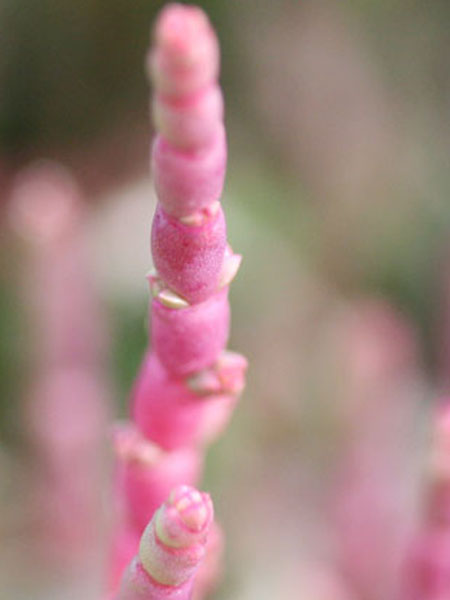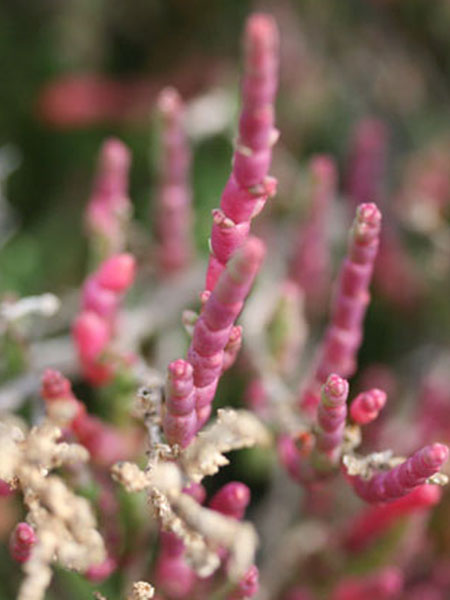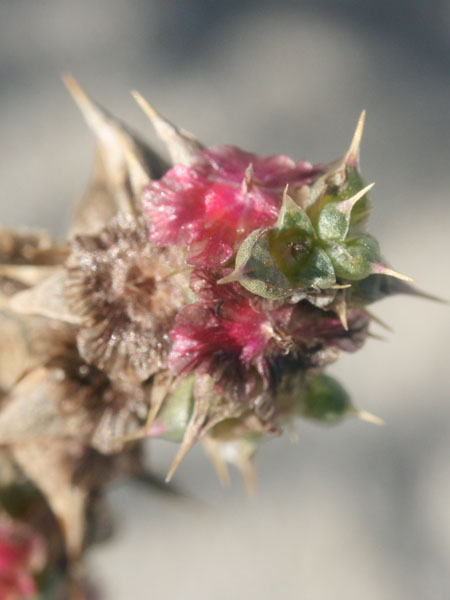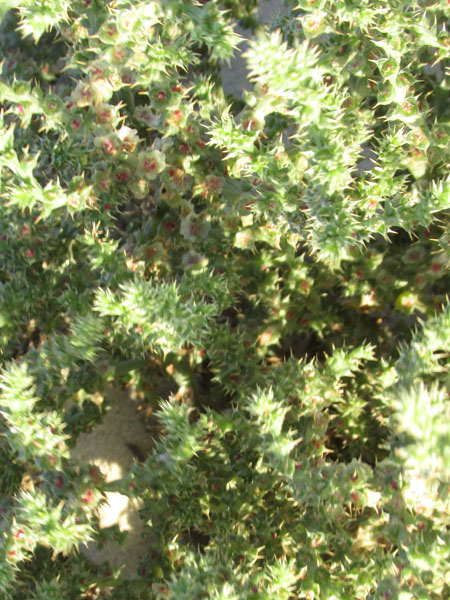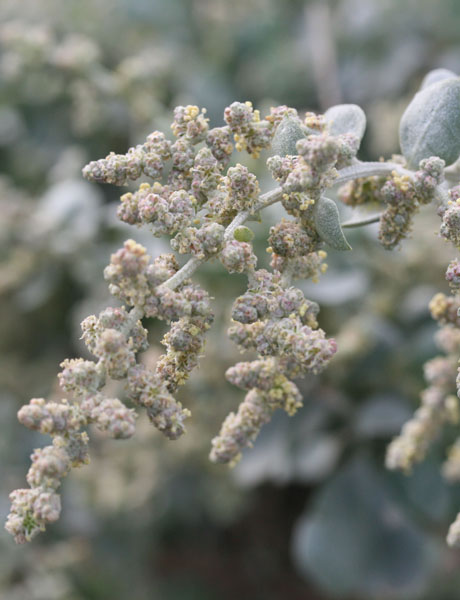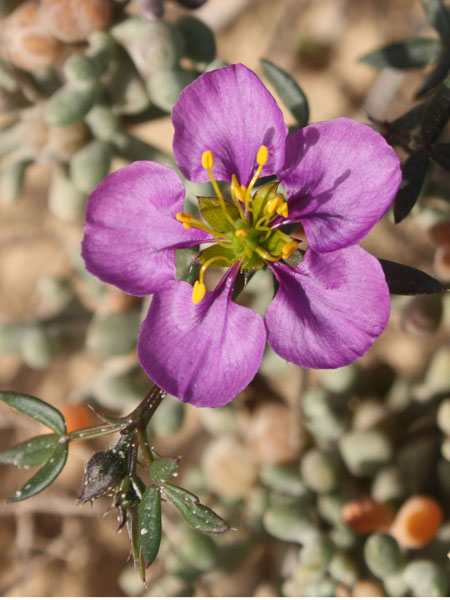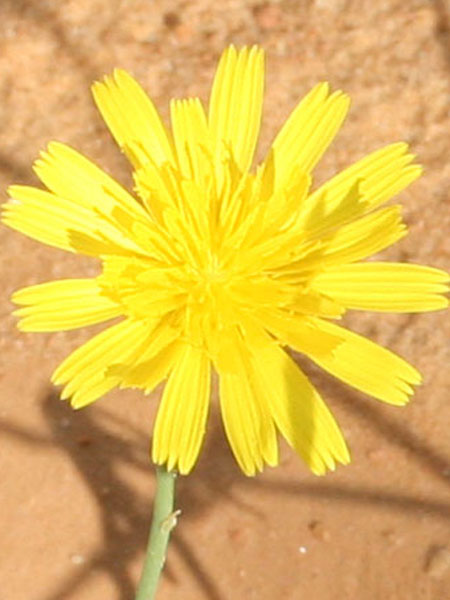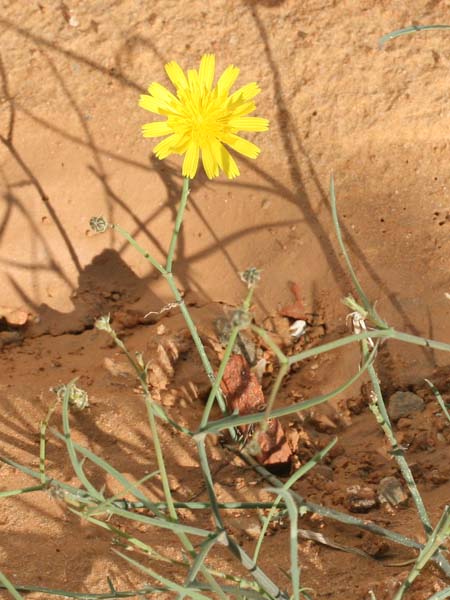Suaeda fruticosa
Kingdom : Plantae / النّباتات
Division : Spermaphyta / البذريات
Clade : Magnoliophyta or Angiospermae / مستورات البذور
Class : Eudicotyledoneae / ذات الفلقتين
Order : Caryophyllales / رتبة القرنفليات
Family : Amaranthaceae [Chenopodiaceae] /فصيلة السّرمقيات أوالرّمراميّة أو القطيفيّة
Genus : Suaeda
species : fruticosa
Chromosomes: 2n=30
Protologue
Forssk. ex J.F. Gmel., Syst. Nat., ed. 13, 2: 503 (1791)
Synonyms
var. brevifolia Moq., Chen. Enum. 122 (1840). var. longifolia (Koch) Fenzl in Ledeb., Fl. Ross. 3: 778 (1851). Suaeda longifolia Koch, Linnaea 22: 188 (1849). Suaeda fruticosa subsp. longifolia (Koch) O. Bolòs & Vigo, Bull. Cat. Hist. Nat. 38: 89 (1974).
Common names
Tunisia Arabic English French Tamazight
حبّة السودة
Shrubby
Alkali seepweed
Shrubby sea-blite
Soude ligneuse
Soude vraie
Toxic
no
Edible
no
Latex
no
Botanic description
Genus description
"Hermaphroditic bracts solitarious or glomerular, in long leafy spikes. Stamens 5. lanceolate Stigmas 3. Accrescent perigone, fleshy or dry, enclosing compressed, membranous fruit. Seed horizontal or vertical.
Species description
"Very shrub branching, forming a bush up to 1 m tall.
Stems very rowers, forming a bush. Leaves cylindrical not exceeding 0.8 cm in length, glaucous, blackening on drying. Flowers usually by 3, rarely solitary in the axilla of each leaf, do not no definite inflorescence. Seeds usually vertical.
Botanic References
Pottier-Alapetite G. (1981). Flore de la Tunisie Angiospermes –Dicotylédones (Apétales- Dialypétale , Première partie). Imprimerie Officielle de la République Tunisienne (Eds), 61p. Edouard LE FLOC’H, Loutfy BOULOS et Errol VELA. (2010). Catalogue synonymique commenté de la FLORE DE TUNISIE. République Tunisienne, Ministère de l’Environnement et du développement durable, Banque Nationale de Gènes. 500 p www.theplantlist.org
Biology
Life form perennial Type form Nanophanerophyte Photosynthesis C4
Phenology
Blooming
JanuaryFebruaryMarchAprilMayJuneJulyAugustSeptemberOctoberNovemberDecember
Fruiting
JanuaryFebruaryMarchAprilMayJuneJulyAugustSeptemberOctoberNovemberDecember
Map Localization
Ecology
Adaptation It grows around salty depressions (sebkhas). Salt bladder yes Invasive no
Geographical distribution
Localization Biocimatic stage Annuel pluviometry (mm) GPS Monastir (Kheniss, Nov.2015) Inferior semi-arid 331 35°43'47.29"N / 10°49'10.64"E Monastir (Akba, Déc.2013) Inferior semi-arid 331 35°45'0.57"N / 10°49'39.86"E Monastir (Sahline, Déc.2013) Inferior semi-arid 331 35°46'15.99"N / 10°42'32.44"E Monastir (Ghedamssi Nov. 2014) Inferior semi-arid 331 35°46'58.13"N / 10°49'59.41"E Cap Bon (Soliman Fév. 2016) Superior semi-arid 444 36°43'29.41"N / 10°28'15.12"E
General uses
Formerly, it was used to make soda. The ashes obtained after combustion of the plant were combined with lime, thus obtaining "caustic soda". This soda was then used in the manufacture of soap in particular. In Djerid, it is used to die wool in black.
Medicinal uses
"The seeds are tonicardiac, anti-infectious and healing propreties. In addition, the decoction of this species contains bioactive substances with hypoglycemic and hypocholesteric properties.
NOTE : This website is not that of herbal medicine and assumes no responsibility for the negative effects of the use of plants. Seek advice from a professional before using a medicinal plant.
Systems / Organs / Effects
Digestive System Circulatory System Antiseptic Hypolipedemic Hypoglycemic Skin
Dispersion mode
Germination
Duration
Image
Description of the seeds
Form External structure Ornamentation Type of seed Average length of 10 seeds ± (mm) Average width of 10 seeds ± (mm) Average thickness of 10 seeds ± (mm) Average mass of 100 seeds 0.6 (g)
Test results
TPC DPPH ABTS+ FRAP Year mg GAE g-1 MS CI50 g ml-1 CI50 g ml-1 CE50 g ml-1 17,48± 0,78 166,75± 3,57 295,11± 3,78 752,04± 75,83 2016 Total Phenols content(TPC), Anti-radical potentialities against (DPPH, ABTS), Ferric reducing antioxidant power(FRAP)
Molecules : ADN / Proteins
Chromosomes : 30 Uniprot NCBI
Chemical composition
Name Phenolic compounds Polyphenols
Flavonoïdes
Simple Phenols
Tannins link
Other compouds Alkaloides
Glucides Polysaccharides
Tunisian references
Boukef M.K. (1986). Les plantes dans la médecine traditionnelle tunisienne. Médecine traditionnelle et pharmacopée. Librairie Larose (Eds), paris, 350p. Chaieb M et Boukhris M. (1998). Flore succincte et illustrée des zones arides et sahariennes de Tunisie. Association pour la protection de la nature et de l’environnement, Sfax. 193 p. Mzoughi Z., Abdelhamid A., Rihouey C., Le Cerf D., Bouraoui A., Majdouba H. (2018). Optimized extraction of pectin-like polysaccharide from Suaeda fruticosa leaves: Characterization, antioxidant, anti-inflammatory and analgesic activities. Carbohydrate Polymers 185: 127–137 Oueslati S, Trabelsi N, Boulaabaa M, Legault J, Abdellya C, Ksouri R.(2012). Evaluation of antioxidant activities of the edible and medicinal Suaeda species and related phenolic compounds Industrial Crops and Products 36. 513– 518 savoirs populaires. IBIS Press. 764 p Oueslati S, Ksouri R, Falleh H, Pichette A, Abdelly C, Legault J. (2012). Phenolic content, antioxidant, anti-inflammatory and anticancer activities of the edible halophyte Suaeda fruticosa Forssk. Food Chem. 132: 943-994
Other references
Bennani-Kabchi N, El Bouayadi F, Kehel L, Fdhil H, Marquie G. (1999). Effect of Suaeda fruticosa aqueous extract in the hypercholesterolaemic and insulin-resistant sand rat. Therapie (England), 54, 725–730. Benwahhoud M., Jouad H., Eddouks M., Lyoussi B. (2001). Hypoglycemic effect of Suaeda fruticosa in streptozotocin-induced diabetic rats. J. Ethnopharmacol. 76: 35-38. El-Hagrasi A.M.A., El-Desouky S.K., El Ansari M.A., Rabie AM.( 2005). Investigation of lipid constituents of pods of Caesalpinia pulcherrima L., aerial parts of Suaeda pruinosa Forssk. and antimicrobial activity of their methanolic extracts. Bull. NRC Egypt. 30, 133–140. Gulzar, S., Khan, A. (1998). Diurnal water relations of inland and coastal halophytic populations from Pakistan. J Arid Envir, 40, 295–305. Ravikumar S, Gnanadesigan M, Inbaneson SJ, Kalaiarasi A. (2011). Hepatoprotective and antioxidant properties of Suaeda maritima (L.) dumort ethanolic extract on concanavalin-A induced hepatotoxicity in rats. Indian J Exp Biol. 49(6):455-60. Shahi, M., Saaghari, M, Zandi Esfahan, E., Jaimand K. (2013). Investigation on potential of Suaeda fruticosa as a source of edible oil. J. Bio. & Env. Sci.2013; Vol. 3, No. 12, p. 101-107.




















